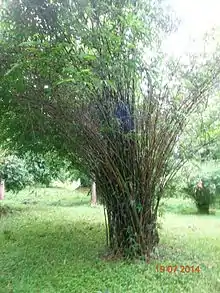| Bambusa tulda | |
|---|---|
 | |
| Scientific classification | |
| Kingdom: | Plantae |
| Clade: | Tracheophytes |
| Clade: | Angiosperms |
| Clade: | Monocots |
| Clade: | Commelinids |
| Order: | Poales |
| Family: | Poaceae |
| Genus: | Bambusa |
| Species: | B. tulda |
| Binomial name | |
| Bambusa tulda | |
| Synonyms[1] | |
|
Dendrocalamus tulda (Roxb.) Voigt | |
Bambusa tulda, or Indian timber bamboo (alternatively spineless Indian bamboo or Bengal bamboo[2]), is considered to be one of the most useful of bamboo species. It is native to the Indian subcontinent, Indochina, Tibet, and Yunnan, and naturalized in Iraq, Puerto Rico, and parts of South America.[1][3][4][5][6][7][8][9][10][11][12][13][14][15][16]
B. tulda is used extensively by the paper pulp industry in India. It can grow to a height of 15 m and a thickness of 8 cm. The single most important fact about Bambusa tulda is its incredible tensile strength; up to 60,000 pounds (27,000 Kg) per square inch. [17] It is commonly found in southeastern Asia[18]
Habit
It is a tall, dull green colored bamboo species with greyish green when mature. It is composed of few closely growing culms. It reaches a height of 6–23 m.
Appearance
Young culms are green, which become greyish green when mature and brown when drying. Young shoots are yellowish green in color with a powdery top. Culms are covered with white blooms. A band of white hairs occurs above the nodes. Branching occurs from the base to top. Aerial roots reach up to few nodes above. Internode length is 30–60 cm, and diameter is 0.8–1.2 cm. Culm walls are very thick. Nodes are prominent.
Culm sheaths are triangular with a conical blade, and straw-colored. The sheath proper is asymmetrical and 15–32 cm in length and 25–34 cm wide. Blade length is 5–10 cm. Auricles are unequal where the large one is rounded and situated on the side of the blade. The upper surface of the sheath is covered with blackish-brown hairs. The lower surface of the sheath is not hairy. Sheaths fall off early.
References
- 1 2 Kew World Checklist of Selected Plant Families
- ↑ Monaco Nature Encyclopedia
- ↑ Flora of China Vol. 22 Page 21, 俯竹 fu zhu, Bambusa tulda Roxburgh, Fl. Ind., ed. 1832. 2: 193. 1832.
- ↑ Bor, N.L. (1968). Flora of Iraq 9: 1–588. Ministry of Agriculture & Agrarian Reform, Baghdad.
- ↑ Karthikeyan, S., Jain, S.K., Nayar, M.P. & Sanjappa, M. (1989). Florae Indicae Enumeratio: Monocotyledonae: 1–435. Botanical Survey of India, Calcutta.
- ↑ Jørgensen, P.M. & León-Yánez, S. (eds.) (1999). Catalogue of the Vascular Plants of Ecuador. Monographs in Systematic Botany from the Missouri Botanical Garden 75: i–viii, 1–1181.
- ↑ Press, J.R. et al. (2000). Annotated Checklist of the Flowering Plants of Nepal: i–x, 1–430. Natural History Museum, London.
- ↑ Noltie, H.J. (2000). Flora of Bhutan 3(2): 457–883. Royal Botanic Gardens, Edinburgh.
- ↑ Kress, W.J., DeFilipps, R.A., Farr, E. & Kyi, D.Y.Y. (2003). A Checklist of the Trees, Shrubs, Herbs and Climbers of Myanmar. Contributions from the United States National Herbarium 45: 1–590.
- ↑ Clayton, W.D., Harman, K.T. & Williamson, H. (2006). World Grass Species – Synonymy database. The Board of Trustees of the Royal Botanic Gardens, Kew.
- ↑ Wu, Z. & Raven, P.H. (eds.) (2006). Poaceae. Flora of China 22: 1–733. Missouri Botanical Garden Press, St. Louis.
- ↑ Newman, M., Ketphanh, S., Svengsuksa, B., Thomas, P., Sengdala, K., Lamxay, V. & Armstrong, K. (2007). A checklist of the vascular plants of Lao PDR: 1–394. Royal Botanic Gardens, Edinburgh.
- ↑ Ahmed, Z.U. (ed.) (2008). Encyclopedia of Flora and Fauna of Bangladesh 12: 1–505. Asiatic Society of Bangladesh.
- ↑ Lepcha, S.R., Sharma, T.P. & Das, A.P. (2009). Diversity and distribution of Bamboos in Pangolakha wildlife sanctuary in Sikkim, India. Pleione 3(1): 13–17.
- ↑ Giraldo-Cañas, D. (2011). Catálogo de la familia Poaceae en Colombia. Darwiniana 49: 139–247.
- ↑ Acevedo-Rodríguez, P. & Strong, M.T. (2012). Catalogue of seed plants of the West Indies. Smithsonian Contributions to Botany 98: 1–1192.
- ↑ McClure, Floyd A. (1948). U.S.D.A yearbook of Agriculture-Grasses-"Bamboos for Farm and Home". Washington, DC: U.S. Dept. of Agriculture. p. 738.
- ↑ Bambusa tulda Archived 2007-08-29 at the Wayback Machine, OzBamboo; Retrieved: 2007-12-19